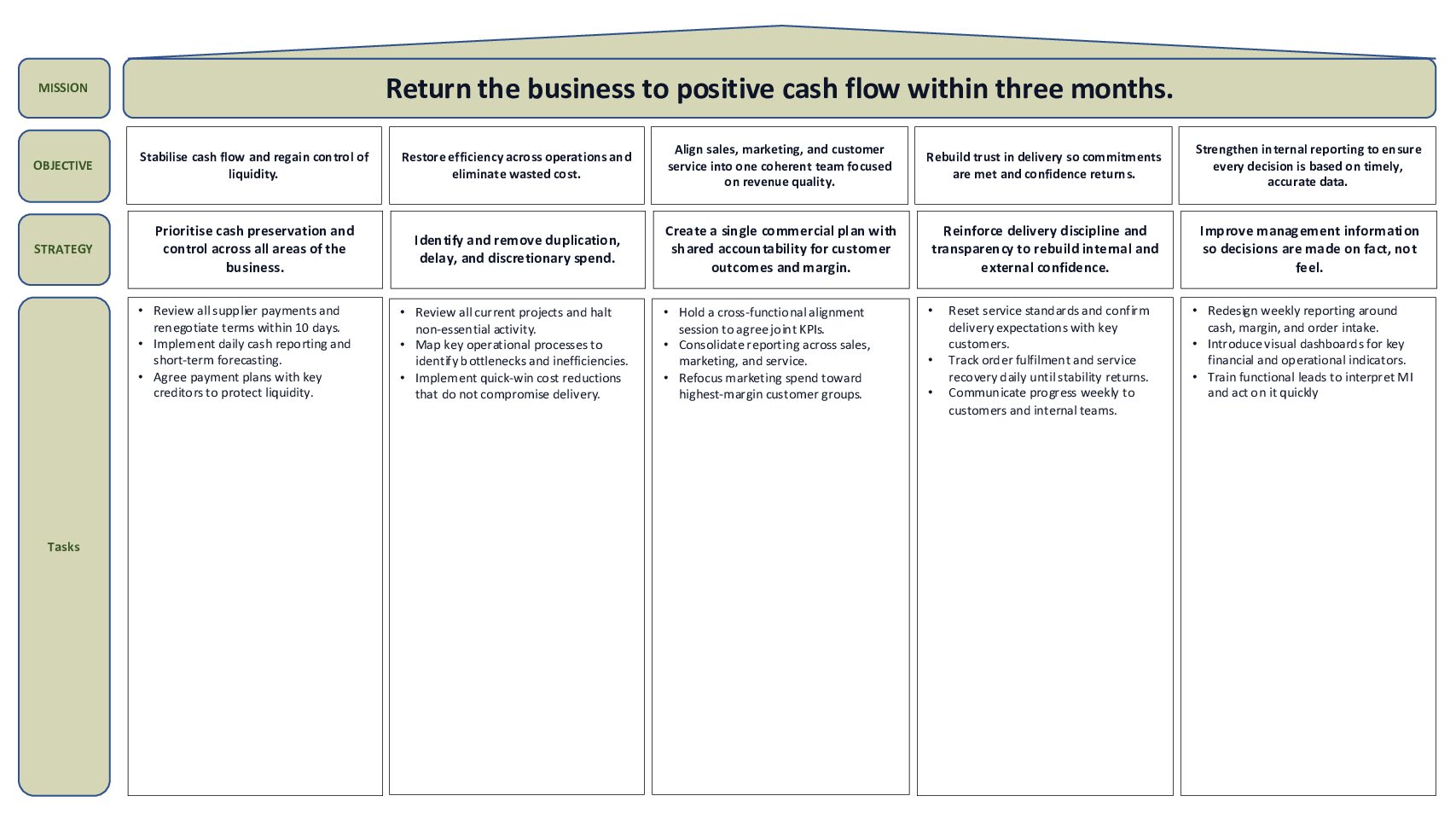Getting Started with Business Recovery
Step One: Change Starts with You
When a business begins to struggle, it rarely happens suddenly. The signs creep in quietly and build over time. Results start to slip. Energy fades. You work harder but feel like you are getting nowhere. Cash tightens, decisions get delayed, and conversations that once felt open and optimistic become guarded.
Nights get longer. You find yourself awake at three in the morning, running numbers in your head or replaying the same meetings, searching for the point where things started to go wrong. Morale has dipped, confidence is fading, and your own motivation has begun to follow.
At that point, most leaders react by acting. They call a meeting, set new targets, or reorganise teams. They look outward. It feels like leadership, but in truth, recovery begins somewhere far less visible. It begins with you.
Before you stride into work determined to tell everyone what needs to change, stop. Take a full day on your own, away from the noise, and lock yourself away from all distractions. No emails. No calls. No meetings. Just you, a notebook, and the truth.
The first step in recovery is not an action plan or a crisis meeting. It is clarity, and that only comes when you are honest with yourself.
Sit with the reality
Every leader hits a point where the weight of responsibility and the constant noise of the job start to cloud judgement. That is when you need to slow down, not speed up. Spend the day writing. Think without interruption.
Ask yourself, plainly and without filter:
-
What is not working in the business?
-
Why is it happening?
-
What is driving the behaviours or results you are seeing?
-
Which of these problems do you directly own?
-
And what do you know, deep down, must change?
This is not about crafting a management presentation. It is about clearing your head. You are gathering unpolished truths before they get diluted by noise or dressed up in language that protects comfort rather than performance.
If you write with honesty, you will notice the tone of what you capture change as you go. The first few sentences may sound defensive or analytical. Then, if you push through that, you will start to find your real thoughts, and they will almost certainly include uncomfortable truths.
Reflect before you decide
Once you have captured what you believe is wrong, sit with it. Let yourself feel the frustration, regret, or even anger that comes with it. Then ask the harder questions:
-
What could I have done differently?
-
Why didn’t I?
-
What do I really want from this business now?
-
Is it still worth fixing?
This is also the time to be brutally honest about your own priorities. Most leaders have pet projects or long-running initiatives that once made sense but now consume time and capital that the business cannot spare.
Ask yourself which projects genuinely move the business forward and which exist because of past pride or attachment. Decide whether to press on, pause, or can them entirely. Letting go of something you created can feel like failure, but in recovery it is often a sign of maturity and discipline.
And while you are being honest, check your pride. Do not let it stop you from asking for help. Every leader reaches a point where support would make a difference, whether from a trusted peer, an advisor, or someone who has been through it before. It is far better to seek help early than to become the last person in the room who still believes they can fix everything alone.
Do not be the ignorant fool who carries on because admitting struggle feels like weakness. Strength is facing reality early enough to change it.
These are not easy questions to answer, but they matter more than any budget reforecast or restructuring plan. Recovery demands energy, and you need to know whether you have the will to lead it. There is no shame in admitting fatigue or doubt, but there is danger in ignoring them.
Taking time to reflect does not weaken your authority. It strengthens it. It reminds you why you started and what kind of leader you want to be on the way back.
Do not worry about solutions yet
At this stage, resist the urge to fix things. Most leaders move too quickly from diagnosis to prescription. They identify a problem and immediately leap into action. Without clarity, action just creates movement, not progress.
Your goal in this first step is to reach the point where you can see the situation as it really is. Where you can say, with quiet confidence: “This is what is happening. This is why. And this is what needs to change.” That is the foundation of recovery.
Look for patterns
Once your thoughts are on paper, take a step back. Read them as if they belonged to someone else. You will start to see themes emerging. Perhaps too many priorities, weak accountability, misplaced incentives, or confusion about direction. You might notice that what you have written is not just about the business, but about your own leadership behaviours. Maybe you have been too involved in detail. Or too distant. Maybe you have been protecting people when they actually needed challenge.
These reflections are valuable. They represent the raw material of recovery. Before you start engaging the wider team, you now have something that resembles the early shape of direction, not a plan but intent.
Define the mission
Before setting objectives, you need a mission: a clear, commercial statement of what you are trying to achieve. This is not about slogans or straplines. It is about defining the practical purpose of the recovery period.
Create a hard-nosed, commercially focused mission, not something you would hear at a beauty pageant. It should be specific, measurable, and rooted in business reality, not aspiration.
Your mission should describe what success looks like in business terms and what you are trying to protect or rebuild.
For example:
-
Return the business to positive cash flow within three months.
-
Regain customer confidence and protect recurring revenue.
-
Create a stable operating model that can fund its own growth.
-
Rebuild internal confidence so the team believes progress is possible again.
This kind of mission acts as a compass. It gives every decision context. If an idea, project, or action does not contribute to that mission, it waits. Recovery work needs focus, not noise.
Once the mission is clear, you can turn it into specific objectives.
Define the first objectives
From what you have written, identify the few areas that instinctively feel critical. The things that, if you do not change them, nothing else will matter. Write them as plain objectives, not stretch goals or aspirations. Keep them simple and practical.
Objectives are the supporting pillars of your mission. They give structure to intent and turn broad ambition into practical focus. When chosen well, they make decision-making faster, priorities clearer, and recovery measurable.
-
Stabilise cash flow and regain control of liquidity.
-
Restore efficiency across operations and eliminate wasted cost.
-
Align sales, marketing, and customer service into one coherent team focused on revenue quality.
-
Rebuild trust in delivery so commitments are met and confidence returns.
-
Strengthen internal reporting so decisions are based on accurate data.
You will be surprised how shaping a recovery strategy in this way simplifies the work streams. If you have done it well, the way forward, although still a hard trek, becomes a series of logical, achievable steps.
These are not yet strategies. They are anchor points, the truths that will hold the recovery process together as you move forward.
Stop, Start, Continue
Once you have clarified the mission and set the first objectives, it is time to translate them into practical action. Recovery is not just about what you will do, but what you will stop doing.
Most businesses in difficulty are weighed down by activities that no longer serve a purpose. Meetings that add little value. Projects that should have ended months ago. Reporting that measures the wrong things. When cash and energy are tight, everything must earn its place.
Now that you have your mission and objectives, it should be straightforward to identify what belongs in each category.
If an activity does not support the mission and objectives, stop it.
If your objectives point to things that need to happen but currently are not, start them.
If something already contributes meaningfully to the mission and objectives, continue it.
Be honest with yourself as you work through this. Do not shoehorn pet projects into the “continue” list just because they carry sentimental weight. The purpose here is clarity, not comfort.
A simple and effective way to create focus is to categorise your next moves as Stop, Start, Continue.
Stop: Identify the workstreams, projects, or routines that no longer contribute to the mission. Be ruthless. If it does not move the business closer to stability, stop it or put it on hold. Every unnecessary task you remove frees capacity for what really matters.
Start: Define the actions and disciplines required to deliver your new objectives. This might include tighter cash controls, weekly performance reviews, a sharper marketing focus, or a daily stand-up to rebuild accountability. Start only what you are prepared to sustain.
Continue: Recognise what is still working and should be protected. There will always be people, customers, or processes that remain solid despite the wider challenges. Preserve these strengths; they are the foundation you build on.
This framework sounds simple, but it is one of the most powerful tools in recovery. It cuts through noise, clarifies priorities, and helps the team see that change is not about doing more, but about doing what matters most.
Strategy and Tasks
With your mission and objectives defined, you now have clarity on what needs to be achieved. Strategy and tasks turn that clarity into movement. They are the parts of the MOST model that translate thought into action.
Strategy defines how you will achieve your objectives. It is about sequence and choice. In recovery, you cannot fix everything at once. The skill is knowing what to do first, what to delay, and what to ignore until stability returns.
Your strategy might start with stabilising cash flow, then rebuilding operational discipline, followed by re-energising sales and customer confidence. Each step must have a clear purpose and ownership.
A good recovery strategy is not complex. It should fit on one side of A4. Any more, and it stops being direct and real.
Tasks bring the strategy to life. They are the daily, visible actions that make recovery real. Without them, plans remain theoretical. Tasks should be specific, time-bound, and achievable within the next few weeks, not months.
For example:
-
Review all supplier payments and renegotiate terms within 10 days.
-
Implement daily cash reporting and short-term forecasting.
-
Identify and remove non-essential spend immediately.
-
Reset the weekly trading report to focus on cash, margin, and order intake.
-
Hold daily team stand-ups to review performance and unblock issues.
-
Contact top ten customers personally to confirm confidence and future orders.
If it is not on the plan, you should not be doing it.
If you absolutely should be doing it, it should be on the plan.
The plan is the discipline. It defines focus, filters noise, and keeps the recovery real.
When you have defined all four parts of the MOST model — Mission, Objectives, Strategy, and Tasks — you have a structure that brings discipline to recovery. It keeps the focus on what matters, in the right order, with clear accountability for delivery.
Example: One-Page Recovery Plan (MOST Framework)
Below is an example of how a short-term recovery mission fits onto a single sheet of A4.
This shows how a clear mission, focused objectives, and aligned strategies and tasks connect to create a practical roadmap for recovery.

Clarity before communication
Many CEOs and MDs feel pressure to act visibly. The team wants reassurance. Investors want direction. But if you skip this stage, you risk communicating from confusion. You cannot lead people somewhere you have not yet defined.
Taking time to think does not mean inaction. It means preparation. The difference between a leader who reacts and one who recovers is that the latter pauses long enough to understand the terrain before moving.
The quiet start to recovery
In every turnaround I have been part of, there comes a moment when the leader’s energy shifts. They stop blaming the market, the product, or the team, and accept that recovery begins with their own clarity. That moment changes everything.
So before you set out to change the business, start by changing your own perspective. Step back. Be honest. Lock yourself away. Write it down. Reflect on what it really means.
The first step to recovery is not what you tell others to do. It is what you tell yourself to face.




